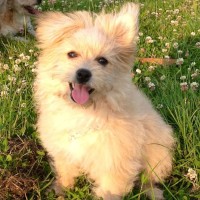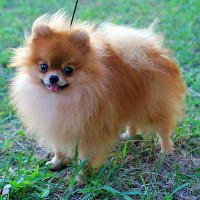Appearance of the Bichon-A-Ranian
|
| This adorable dog will take on some of the physical characteristics of the Spitz Toy / Pomeranian and the Bichon à poil frisé. They are small and short-legged, with a short, hairy tail. The Bichon Frise is a puffy dog with a thick layer of loose curls. Some Bichon Frises are cut to be round, especially if they make their appearance in the ring. Pets that stay at home as pets can be cut shorter to make their coats lower-maintenance. Their noses are black and the eyes will be dark and expressive. They have pure white fur and a feathered tail that falls over their back. The Spitz Toy / Pomeranian is also small and fluffy, with small erect ears on top of wedge-shaped heads. They have slightly rounded skulls and brilliant almond-shaped eyes that will be dark in color. These dogs will have noses and eyes that are the same color as the coat, or black. Their thick, coarse coat will have ruffles on the chest and around the head. The feathered tail spreads over the dog's back. |
Temperament of the Bichon-A-Ranian
|
| These dogs are generally not good with children, but should be fine if raised with them. They will get along best with calm children, but as these dogs can have the temperament of a Spitz Toy / Pomeranian, they could lash out at a child who catches them. They can get lonely if left alone for long periods, as they are so affectionate and family-oriented. |
Needs and activities of the Bichon-A-Ranian
|
| The Bichon-A-Ranian is a hybrid breed that will take on the personalities of the Bichon à poil frisé and the Spitz Toy / Pomeranian. They are intelligent and respond to training when it is consistent and gentle. They are loyal and loving, making them great pets that will be affectionate and protective. All dogs, whatever their breed, will benefit from socialization and obedience training early in life. This will ensure that they are confident, respectful dogs who will listen to the owner's commands and get on well with other pets and people. |
Maintenance of the Bichon-A-Ranian
|
| The Bichon-A-Ranian's long, fluffy coat will look its best if brushed daily. Bathe these dogs if necessary. Maintenance can be different, depending on the parent from which it adopts its coat. If their coat is curly, like the Bichon à poil frisé, it will need to be groomed more often than the straight-coated Spitz Toy / Pomeranian. Bichon Frises are prone to skin allergies and other problems. Therefore, it's important to stay on top of coat care. They have fur that could tangle in water, so always brush them before bathing. These more Spitz Toy / Pomeranian-like hybrids will need brushing at least twice a week to remove tangles and debris from their fur. To keep their coats clean, trim the fur around the ears, back, face and feet. Small breeds like these are prone to dental disease, so brushing their teeth at least two or three times a week is a must, although every day is preferable. Also clean your dog's ears weekly and trim his nails monthly. |









 English (United Kingdom)
English (United Kingdom)